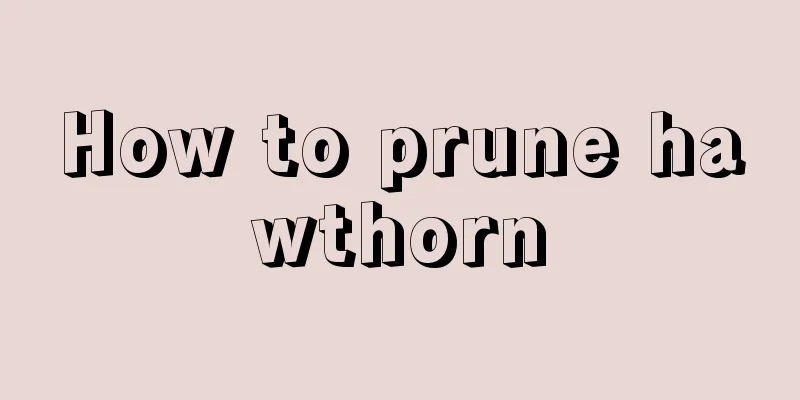How to prune hawthorn

Hawthorn tree pruningWhen pruning hawthorn, you can choose a sparse layered shape, a multi-branched closed heart shape, or a natural open heart shape. When shaping and pruning, attention should be paid to adjusting the shape of the tree with a skewed crown. Principles of hawthorn pruningWhen pruning young hawthorn trees, the principle is to cut lightly and leave more branches, and cut upright branches and competing branches short. In the second year, the strong ones are removed and the weak ones are kept or the growth is slowed down. The extension branches of the central trunk are pruned back, and the direction of the buds at the cut is opposite to that of the previous year. This practice can correct the skewing of the young trees. The extension branches of the main and side branches should be cut short, leaving the outer buds to open the angle. During the initial fruiting period of hawthorn, the extension branches of the main branches at all levels can be shortened to maintain the subordinate relationship and balance the tree vigor. Thin out crowded branches, overcrowded branches, or cut them back to transform them into large fruiting branches, and thin out overcrowded branches. During the peak fruit-bearing period of hawthorn, attention should be paid to ventilation and maintaining good light conditions. At this time, it is necessary to short-cut the new branches outside the crown, strengthen the growth of nutrient branches, and back-prune to rejuvenate the fruiting branches. In addition, overlapping branches, overly dense branches, crossed branches, and diseased and insect-infested branches should be pruned off. The tips of large branches are drooping and can be slightly pruned back, leaving lateral or oblique upward branches. When pruning the fruiting branches of hawthorn, the weak ones should be cut off, leaving the strong ones, and the thin ones should be removed, leaving the strong ones, to adjust the density of the branch groups. Prune the strong branches within the branch group as reserve branches to prevent the phenomenon of alternate bearing years. Reasonable use can be made of the overgrown branches, which can be cultivated into fruiting branch groups through pruning and pinching in summer. For hawthorn trees over 10 years old, thinning should be the main method, and diseased and insect-infested branches, dead branches, and overly dense branches should be cut off to keep the crown symmetrical and the branches appropriately sparse to facilitate ventilation and light transmission. |
<<: How to propagate Trachelospermum jasminoides
>>: How to grow daffodils in sand
Recommend
How to grow double-line arrowroot
1. Maintenance conditions 1. Flower soil: The flo...
How to remedy the problem of rubber tree leaves turning yellow and falling off?
The rubber tree is an evergreen woody foliage pla...
Cultivation methods and precautions of Japanese saxifrage
1. Breeding methods 1. Soil: It prefers sandy soi...
How to make bell peppers sprout quickly
Pepper germination environment Every time you pla...
Is rosemary suitable for deep or shallow pots?
Should I use a deep or shallow pot for rosemary? ...
How to propagate ice plum and what to pay attention to
Ice plum reproduction method There are three main...
The role of zapota
The role of zapota Ornamental effect The appearan...
How much does it cost to plant one acre of Polygonatum?
1. How much does it cost to plant one acre of Pol...
What are the cultivation methods and precautions of coleus
Coleus Introduction Coleus is a plant of the Lami...
How to grow grapes in pots? Planting methods and key points of grape pots
Grape pot cultivation method 1. Light: When grape...
Summer flowers dry up quickly when exposed to the sun. Learn this trick and their leaves will immediately become juicy!
Minor sunburn The ultraviolet rays in summer are ...
Peanut planting conditions and regional climate and soil requirements
Peanut Planting Conditions 1. Temperature conditi...
The difference between Baocao and Gyokuro
1. Differences in plants The plant of Baocao is r...
How to propagate Dracaena by cuttings?
Dracaena is an easy-to-care-for indoor plant that...
How to take care of the newly bought Cattleya
1. Lighting Newly bought Cattleya should be place...









